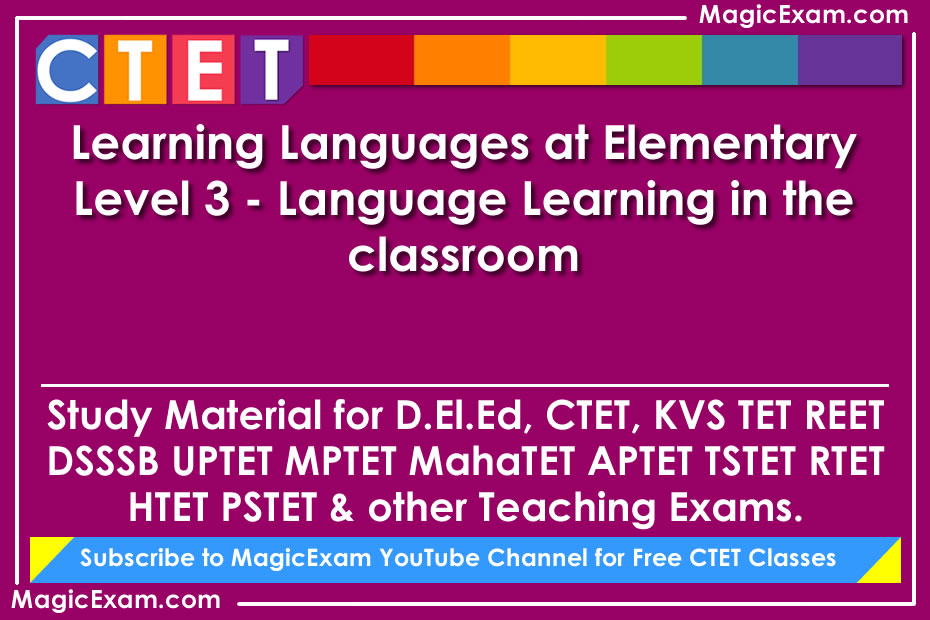The PDF file below covers the chapter Learning Languages at Elementary Level 3 – Language Learning in the classroom. The specific topics and contents of the file are listed below.
This study material is useful for the study and revision of the essential and important concepts of Child Development & Pedagogy, Mathematics Pedagogy, EVS Pedagogy, Social Science Pedagogy and Language Pedagogy for CTET Paper 1 and Paper 2 and other teaching exams, such as KVS, TET, REET, DSSSB, UPTET, MPTET, MahaTET, APTET, TSTET, RTET, HTET KARTET, TNTET and PSTET.
Check out the MagicExam.com - CTET & Teaching Exams Study Material page for other preparation books from this series.
We have answered and solved the questions from various CTET question papers 1 and 2 on our YouTube channel.Subscribe to MagicExam YouTube channel for free videos on CTET 2025 and 2026, KVS, TET, REET, DSSSB, UPTET, MPTET, MahaTET, APTET, TSTET, RTET, HTET, PSTET and other teaching exam preparation, solved question papers, syllabus analysis, result related news and other information videos.
If you have any questions, comments or feedback - please post them as YouTube comments under the specific videos and we will clarify or reply as soon as possible.
Contents covered in this part of the PDF book under Learning Languages at Elementary Level 3 – Language Learning in the classroom
Unit 7 : Literature and Language
- 7.0 Introduction
- 7.1 Learning Objectives
- 7.2 Literary Devices
- 7.3 Role of literature in language teaching
- 7.3.1 What is literature?
- 7.3.2 Forms of literature
- 7.3.3 Use of literature in language teaching: historical perspective
- 7.4 Objectives of literature teaching
- 7.4.1 Types of classroom
- 7.4.2 First language and second language (or foreign language) classroom
- 7.4.3 Development of various skills through literature
- 7.5 Various forms of literature
- 7.5.1 Basis for including forms in primary and upper primary classes
- 7.5.2 How to use literary forms in classroom?
- 7.5.3 Facing problems in the classroom
- 7.6 Let Us Sum Up
- 7.7 Suggested Readings and References
- 7.8 Unit-End Exercises
Unit 8 : Language Teaching Methods in Classroom Settings
- 8.0 Introduction
- 8.1 Learning Objectives
- 8.2 Significance of making lesson plans
- 8.3 What is a lesson plan?
- 8.4 Components of a lesson plan
- 8.4.1 What to teach
- 8.4.2 Whom to teach
- 8.4.3 Assessment mechanisms
- 8.4.4 Tools of lesson plan
- 8.5 Planning a cluster of lessons
- 8.6 Model lesson plans
- 8.6.1 Tulika’s classroom
- 8.6.2 Satpura ke ghane jungal
- 8.6.3 Teaching alphabet
- 8.6.4 Radha’s classroom
- 8.6.5 Story telling techniques
- 8.7 Posters and advertisements
- 8.8 How to make lesson plans?
- 8.9 Let Us Sum Up
- 8.10 Suggested Readings and References
- 8.11 Unit-End Exercises
Unit 9 : Educational Materials : Some New Dimensions
- 9.0 Introduction
- 9.1 Learning Objectives
- 9.2 Materials essential for education
- 9.3 Why educational materials?
- 9.4 Teaching-learning materials or teaching aid
- 9.5 Models and objects for display
- 9.6 How TLM helps?
- 9.7 What is good education material?
- 9.8 What once can be done with just one material?
- 9.9 Use of cards in teaching language
- 9.10 Materials in language teaching in the context of what learning means
- 9.11 Possible materials for a language classroom
- 9.12 Availability of materials
- 9.13 How to use materials?
- 9.14 How to choose materials? Unit-end Exercises
- 9.15 Let Us Sum Up
- 9.16 Suggested Readings and References
- 9.17 Unit-End Exercises
Unit 10 : Assessment
- 10.0 Introduction
- 10.1 Learning Objectives
- 10.2 Present ways of assessment.
- 10.3 Why assessment
- 10.4 Points of assessment in language
- 10.4.1 Listening and speaking
- 10.4.2 Writing
- 10.4.3 Expression
- 10.5 Ways of assessment in language
- 10.5.1 Oral testing
- 10.5.2 Observation
- 10.5.3 Written test
- 10.6 Activities for assessing prose, verse and drama.
- 10.6.1 Poetry
- 10.6.2 Prose
- 10.6.3 Drama
- 10.7 Let Us Sum Up
- 10.8 Suggested Readings and References
- 10.9 Unit-End Exercises
This study material was originally published on the National Institute of Open Schooling – NIOS website as part of the study material for the Diploma in Elementary Education (D.El.Ed) programme.
If you have any questions or doubts related to Learning Languages at Elementary Level 3 – Language Learning in the classroom or other topics under Child Development & Pedagogy, Mathematics, EVS, Social Science or other subjects for CTET Paper 1 and Paper 2 and other similar teaching exams, such as KVS, TET, REET, DSSSB, UPTET, MPTET, MahaTET, APTET, TSTET, RTET, HTET, KARTET, TNTET and PSTET, you can contact us through the comments section of any video on the MagicExam YouTube channel.
Check out the MagicExam.com - CTET, TET and other Teaching Exams Study Material page for other preparation books and material from this series.
We have answered and solved the questions from various CTET previous question papers 1 and 2 on our YouTube channel.Subscribe to MagicExam YouTube channel for free videos on CTET 2025 and 2026, KVS, TET, REET, DSSSB, UPTET, MPTET, MahaTET, APTET, TSTET, RTET, HTET, PSTET and other Teaching exam preparation, solved question papers, syllabus analysis, result related news and other information videos.
